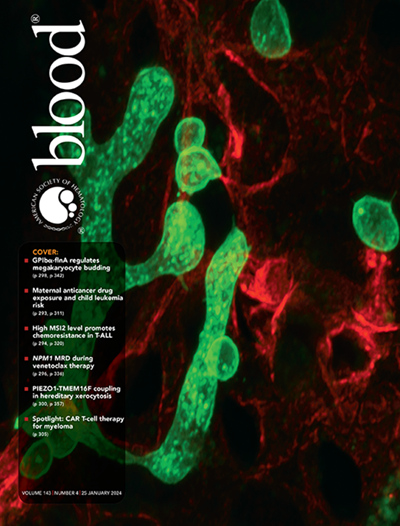Preclinical characterization of TGRX-678, a brain-penetrant allosteric inhibitor of BCR::ABL1.
IF 21
1区 医学
Q1 HEMATOLOGY
引用次数: 0
Abstract
Clinical resistance or intolerance to tyrosine kinase inhibitors (TKIs) remains challenging for the treatment of chronic myeloid leukemia (CML) and Philadelphia-chromosome positive acute lymphoblastic leukemia (Ph+ ALL) with central nervous system (CNS) relapse. Therapeutic options are currently limited for patients who developed the gatekeeper mutations or compound mutations. Here, we describe the preclinical profile of TGRX-678, an allosteric inhibitor designed to Specifically Target the ABL1 Myristoyl Pocket (STAMP), with potent anti-proliferative activity against the majority of ATP site mutants of BCR::ABL1 and minimal off-target cytotoxicity. When combined with ponatinib, TGRX-678 synergistically re-sensitizes the highly resistant compound mutants and T315M to growth inhibition at clinically achievable concentrations. TGRX-678 exhibits relatively high cell permeability and is not a substrate of drug efflux transporters, namely ABCB1 and ABCG2. It also demonstrates a markedly improved in vivo pharmacokinetic (PK) profile and higher oral bioavailability compared to asciminib. Importantly, TGRX-678 penetrates the blood-brain barrier (BBB) and exhibits in vivo efficacy in a murine CNS blast crisis leukemia model. Collectively, these findings suggest that TGRX-678 is a novel BCR::ABL1 allosteric inhibitor with high selectivity, potency and unique pharmacologic features, which has the potential to treat relapse or refractory CML and Ph+ ALL, even with CNS involvement.BCR::ABL1脑渗透变构抑制剂TGRX-678的临床前特征
对于慢性髓性白血病(CML)和费城染色体阳性急性淋巴细胞白血病(Ph+ ALL)伴有中枢神经系统(CNS)复发的治疗,临床对酪氨酸激酶抑制剂(TKIs)的耐药或不耐受仍然具有挑战性。目前,对于发生守门人突变或复合突变的患者,治疗选择有限。在这里,我们描述了TGRX-678的临床前特征,TGRX-678是一种专门针对ABL1肉豆醇口袋(STAMP)设计的变抗抑制剂,对BCR::ABL1的大多数ATP位点突变体具有有效的抗增殖活性,并且具有最小的脱靶细胞毒性。当与ponatinib联合使用时,TGRX-678协同作用使高耐药化合物突变体和T315M在临床可达到的浓度下对生长抑制再致敏。TGRX-678具有较高的细胞通透性,并不是药物外排转运体ABCB1和ABCG2的底物。与阿西米尼相比,它还显着改善了体内药代动力学(PK)特征和更高的口服生物利用度。重要的是,TGRX-678可穿透血脑屏障(BBB),并在小鼠中枢神经系统母细胞危象白血病模型中表现出体内疗效。综上所述,TGRX-678是一种新型的BCR::ABL1变烯抑制剂,具有高选择性、强效和独特的药理学特性,具有治疗复发性或难治性CML和Ph+ ALL的潜力,甚至涉及中枢神经系统。
本文章由计算机程序翻译,如有差异,请以英文原文为准。
求助全文
约1分钟内获得全文
求助全文
来源期刊

Blood
医学-血液学
CiteScore
23.60
自引率
3.90%
发文量
955
审稿时长
1 months
期刊介绍:
Blood, the official journal of the American Society of Hematology, published online and in print, provides an international forum for the publication of original articles describing basic laboratory, translational, and clinical investigations in hematology. Primary research articles will be published under the following scientific categories: Clinical Trials and Observations; Gene Therapy; Hematopoiesis and Stem Cells; Immunobiology and Immunotherapy scope; Myeloid Neoplasia; Lymphoid Neoplasia; Phagocytes, Granulocytes and Myelopoiesis; Platelets and Thrombopoiesis; Red Cells, Iron and Erythropoiesis; Thrombosis and Hemostasis; Transfusion Medicine; Transplantation; and Vascular Biology. Papers can be listed under more than one category as appropriate.
 求助内容:
求助内容: 应助结果提醒方式:
应助结果提醒方式:


